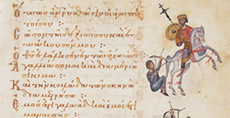sommario 4/2013
 Editoriale
Editoriale
Questo numero segna un punto di svolta nella felice storia di GNOSIS.
Nata nel 1995 con il nome Per Aspera ad Veritatem, la Rivista italiana di Intelligence, tra le poche a livello internazionale edite da un’agenzia di Intelligence, ha saputo evolversi nel corso degli anni in un continuo processo di adeguamento ai mutevoli scenari, nazionali e globali, della sicurezza, al fine ultimo di contribuire alla diffusione della cultura dell’intelligence nel nostro Paese.
Il quadro globale è estremamente fluido ed è caratterizzato da una crescente “a-polarità” del sistema internazionale che si sostanzia, a ben vedere, se non in un vero e proprio deficit di leadership, sicuramente in un progressivo allentamento dei fattori di ordine, di quegli elementi, cioè, che contribuiscono a dare certezza e sicurezza...
|
 Paul Bremer
Paul Bremer

Punto di vista - Il ruolo dell’America nel XXI secolo
L’America è a un punto di svolta della propria storia. Tre quarti degli americani di oggi sono nati dopo la fine della Seconda guerra mondiale; sono cresciuti in un mondo di sempre maggiore libertà (individuale, commerciale e di navigazione dei mari); quasi danno per scontato il mondo di libertà politica ed economica che hanno ereditato.
Il progresso verso un ordine mondiale più libero e aperto non è stato, però, sempre così scontato. L’accademico americano Robert Kagan scrive che il carattere e i valori di una potenza egemone nel mondo determinano la natura dell’ordine internazionale: un ordine mondiale di politica ed economia liberale è potuto fiorire solo quando c’è stata una grande potenza che abbia promosso quei valori...
|
 Araldica
Araldica
Nel lungo passato dell’Agenzia Informazioni e Sicurezza Esterna sono stai individuati quattro simboli. Dei primi due si sa ben poco. Quello riprodotto in bianco e nero era in uso al SIFAR negli anni cinquanta e il successivo, con i due emisferi, lo è stato per decenni sino al 2004, quando il SISMi decise di adottare uno stemma araldico. Il punto di partenza fu quest’ultimo logo il quale accoglieva, tra tanti elementi, un braccio che, reggendo un’asta accesa, muove dalla base di un braciere intorno al cui piedistallo si avvolge un serpente, segno di saggezza e durata. Su una lista permaneva il motto Omnia Silendo Ut Audeam Nosco. Modellato araldicamente il braciere divenne una torcia con ampie fiamme, inserita in uno scudo di forma appuntata sormontato da una corona nuova ed esclusiva, formata da un cerchio d’oro sul quale insistevano dodici torri in luogo delle otto abituali...
|

 Nathan Morello
Nathan Morello
 L’intelligence degli Assiri
L’intelligence degli Assiri
Quali sono le principali conoscenze odierne sul fenomeno dello spionaggio nell’impero assiro? Sebbene non si possa parlare di una vera e propria organizzazione governativa di intelligence, numerose fonti in nostro possesso restituiscono un quadro nel quale personaggi di vario tipo e grado agirono “dietro le quinte” per conto dei sovrani assiri, quali strumenti indispensabili nel quadro delle strategie dell’impero.

 Nathan Morello
Nathan MorelloEspionage in the Neo-Assyrian Empire
The article describes the different forms of Intelligence activities found in the sources of the Neo-Assyrian era (X-VII Century BC). In particular, a conspicuous number of epistolary texts going back to the 8th and 7th Century bear witness to the strategic-military activities promoted by those rulers who transformed the Assyrian kingdom into the first trans-regional empire of history (as it is often called), gaining control of almost the entire Near East, from the coasts of the Mediterranean Sea to those of the Persian Gulf and from the chains of the Taurus and the Zagros, which surround the Land of the Two Rivers, to the Syrian Desert.
|

 Leonardo Quattrocchi
Leonardo Quattrocchi
 La Rana bollita, gli occhi del Camaleonte
La Rana bollita, gli occhi del Camaleonte e il Marketing intelligence
Il Marketing intelligence è un eccezionale strumento per il vantaggio competitivo. Gli approcci e i mezzi per una Intelligence Competitiva sono utilizzati da aziende che vogliono confrontarsi non solo nel presente ma per il futuro, con azioni che dalla raccolta delle informazioni mirino alla ricerca del miglior approccio di mercato. L’analisi dei competitori, delle tecnologie e delle loro tendenze, il monitoraggio del mercato e dei requisiti del cliente sono alcuni tra i dati utili per la trasformazione delle informazioni in intelligence, soprattutto in un periodo di crisi che sempre più richiede accortezza negli investimenti e nel giusto posizionamento competitivo.

 Leonardo Quattrocchi
Leonardo QuattrocchiThe Boiled Frog, the Eyes of the Chameleon and Marketing Intelligence
If you put a frog into hot water, it will quickly spring out of it. If instead you put a frog into cool water and heat it slowly, it will stay in the water until it dies.This paper describes how Marketing Intelligence can sense the changes in the fierce competitive environment that companies live in, such changes being so slow as to be imperceptible and at the same time so rapid that is paramount to act well in advance. The author describes the main tasks of Marketing Intelligence, from information gathering to their analysis and their transformation into usable intelligence. The organization which a company must set up to survive in the highly competitive scenarios of today and the knowledge which stems from a well-balanced Marketing Intelligence is discussed.
|

 Alain Charbonnier
Alain Charbonnier
 Appuntamento con la morte
Appuntamento con la morte per l’‘inglese sconosciuto’
Un’operazione sfortunata e un agente inglese ‘bruciato’ alla sua prima missione, nel gennaio 1943. Scampato al processo e alla pena di morte come spia, dopo un anno e mezzo finisce fucilato dai tedeschi presso La Storta, località alle porte di Roma, insieme con altri tredici compagni di sventura. Quando le salme vengono ritrovate, l’inglese non viene identificato; il braccio operativo del Servizio segreto britannico, lo Special Operations Executive, stranamente sembra dimenticarsi di lui, sul monumento che ricorda l’eccidio figura come ‘inglese sconosciuto’. E tale rimane fino al 2009, quando le ricerche dello storico Gian Paolo Pelizzaro identificano lo sconosciuto in John Armstrong, nome in codice di Gabor Adler, di origine ungherese, arruolato nell’esercito di Sua Maestà. Una storia che racconta di una missione di spionaggio con obiettivi ambiziosi, gravi errori, doppi giochi, umane debolezze ed eroiche solidarietà, fino alla tragedia finale.

 Alain Charbonnier
Alain CharbonnierAppointment with death for the ‘unknown Englishman’
An ill-fated operation and an English agent ‘burnt-out’ on his first mission in January 1943. Escaping trial and the death sentence as a spy, he is finally shot by the Germans on the outskirts of Rome, together with thirteen other companions. When the bodies are found, the Englishman is not identified; the Special Operations Executive, the operative branch of the British Secret Service, strangely enough seemed to have forgotten him. On the tombstone commemorating this massacred figure are written the words ‘the unknown Englishman’. Thus it remained until 2009, when research by the historian, Gian Paolo Pelizzaro identifies the Unknown as John Armstrong, the code name of Gabor Adler, of Hungarian origin, enrolled in His Majesty’s Army. A story that tells of a spy mission of ambitious objectives, serious errors, double dealing, human weakness and heroic solidarity, until the final tragedy.
|

 Corrado Maria Daclon
Corrado Maria Daclon
 - Matteo Pizzigallo
- Matteo Pizzigallo
 Geopolitica dell’ambiente e dell’energia
Geopolitica dell’ambiente e dell’energia
GNOSIS dedica alla geopolitica dell’ambiente e dell’energia uno spazio curato da Corrado Maria Daclon, insieme a Matteo Pizzigallo per gli approfondimenti di carattere storico. Le analisi strategiche, a medio e lungo termine, e le conseguenti ripercussioni in ambito globale, regionale e locale prendono avvio dal ruolo svolto dai gasdotti nei vari paesi dell’ex Urss e nei singoli Stati membri dell’Unione Europea, non ultimo l’Italia che fa risalire addirittura al 1938 il suo primo pioneristico gasdotto. Il tutto in un complicato intreccio di esportazioni di gas e petrolio che vede ormai nella Russia un ‘petro-Stato’ sempre più egemone.

 Corrado Maria Daclon - Matteo Pizzigallo
Corrado Maria Daclon - Matteo PizzigalloEnvironment and energy geopolitics
Starting from this issue of Gnosis, space will be dedicated to the geopolitics of the environment and energy. It will be edited by Corrado Maria Daclon and assisted by Matteo Pizzigallo in the more in-depth historical details. The medium and long-term strategic analyses and the consequent repercussions at global, regional and local levels start from the role played by the gas ducts in the various Countries of the former USSR and in the single Member States of the EU and, not least, in Italy whose first pioneer gas duct goes back to 1938. The whole thing is a complicated web of gas and oil exportations which today sees in Russia an ever increasing hegemonic ‘petro-State’
|

 Filippo Aragona
Filippo Aragona
 Corte penale internazionale e diritti fondamentali
Corte penale internazionale e diritti fondamentali
Nel testo si mette in rilievo il ruolo della Corte Penale Internazionale nel quadro evolutivo della tutela dei diritti umani, ponendo al centro del dibattito l’effettività dei diritti e lasciando sullo sfondo le teorie inerenti al loro fondamento. L’autore riflette su recenti prese di posizione da parte di alcuni governi africani che hanno dato inizio a una polemica sulla reale universalità della giurisdizione della Corte, alle quali ha fatto seguito un duro intervento in « The New York Times» di Desmond Tutu, Anglican Archbishop of Cape Town (premio Nobel per la pace nel 1984), a favore della Corte Penale Internazionale.

 Filippo Aragona
Filippo AragonaInternational Criminal Court and Fundamental Human Rights
This text highlights the role of the International Criminal Court in the evolutionary context of the protection of human rights, placing in the foreground of the debate the effectiveness of the rights and leaving in the background the theories related to their foundation. In this regard the author considers recent positions taken by certain African Governments which have unleashed a controversy on the real universality of the jurisdiction of the Court. This was followed by a harsh intervention in the “New York Times” by Desmond Tutu, Anglican Archbishop of Cape Town (Nobel Prize for Peace 1984), in favour of the International Criminal Court
|

 Luisa Franchina
Luisa Franchina
 Le infrastrutture critiche
Le infrastrutture critiche e la protezione cibernetica nazionale
Anche se con un po’ di ritardo, l’Italia si sta allineando agli altri Paesi occidentali nei settori della protezione delle Infrastrutture Critiche e della sicurezza cibernetica: i due aspetti sono come due cerchi, in parziale sovrapposizione, ma non esattamente coincidenti. L’articolo, sull’onda della pubblicazione del DPCM che ha disegnato, in un contesto unitario e integrato, l’architettura istituzionale deputata alla protezione delle Infrastrutture Critiche e alla tutela della sicurezza informatica nazionale, descrive un’attenta disamina dello stato dell’arte organizzativo in Italia, muovendo da un parallelo con eventi che hanno interessato altri paesi, e confronta la nostra visione con quella di altri stati e dell’Unione Europea, in grado di influenzare e talvolta di ‘trascinare’ le azioni normative e applicative italiane.

 Luisa Franchina
Luisa FranchinaThe protection of the Critical Infrastructures and the national cybernetic security
Albeit with a little delay, Italy is aligning itself with the other Western Countries in the sectors of protection of the Critical Infrastructures and the Cybernetic Security: the two aspects are like two circles, partially overlapping, but not exactly coinciding. The article, in the wake of the DPCM (Decree Council of Ministers) publication that outlined, in a uniform and integrated context, the institutional architecture delegated for the protection of the Critical Infrastructures and the National Cyber Security, offers a careful examination of the organizational state of the art in Italy, moving from a parallel with events that have affected other Countries, and comparing our perception with that of other States and the European Union able to influence and, at times, ‘pull along’ the Italian regulatory and applicative actions.
|

 Giampaolo Rugarli
Giampaolo Rugarli
 Storie di chi si è dato coraggio
Storie di chi si è dato coraggio Nicolò e Giuseppe De Carli
Continuiamo nella presentazione dei decorati di Medaglia d’Oro al Valor Militare, conferita ad appartenenti del mondo dell’intelligence per la straordinarietà del loro comportamento nell’assolvimento della missione affidata. Lo scopo è ricordare quanti ci hanno lasciato in eredità lezioni di rettitudine e orgoglio di appartenenza, con racconti di fantasia che pur attingono a eventi che hanno realmente coinvolto i protagonisti.

 Giampaolo Rugarli
Giampaolo Rugarli

The Honoured. Nicolò and Giuseppe De Carli
As announced in the previous issue, Gnosis plans to present to the readers the stories of those decorated with the Gold Medal of Military Valour, conferred on members of the world of Intelligence for exceptional conduct in the performance of the mission entrusted to them. Our intention is to remember how much they have left us as a legacy of lessons of unconditional honesty and pride in belonging. The pages are enlivened with stories of fantasy which have their roots in events that have truly involved the protagonists. The first instalment has been reserved for the introduction of the series of articles and to the remembrance, ever present, of Nicola Calipari. In this issue, we tell the story of the De Carli brothers, Nicolò and Giuseppe.
|

 Edward Luttwak
Edward Luttwak
 - Gianandrea Gaiani
- Gianandrea Gaiani
 Intelligence e intercettazioni
Intelligence e intercettazioni
Coniugare Ragion di Stato e Privacy rappresenta da sempre un problema complesso per tutte le democrazie occidentali. L’Italia, pur riconoscendo l’esigenza di svolgere attività border line da parte dei Servizi a salvaguardia della sicurezza nazionale, ha saputo darsi una legislazione, quella del 2007, che garantisce avanzati livelli di tutela dei cittadini. È questa, in sintesi, l’opinione del Sen. Marco Minniti, Sottosegretario alla Presidenza del Consiglio dei Ministri, pubblicamente espressa in occasione della presentazione di questa Rivista d’intelligence, il 29 ottobre 2013 alla presenza di membri del Comitato Parlamentare per la Sicurezza della Repubblica.
L’Autorità Delegata, in un momento così delicato per i rapporti tra Europa e Stati Uniti, a seguito della nota vicenda Datagate, ha inteso sgombrare il campo da ogni possibile dubbio interpretativo sulla correttezza istituzionale degli apparati d’intelligence italiani, annunciando un Protocollo d’intesa tra il Comparto e l’Autorità Garante per la Privacy, poi siglato l’11 novembre successivo.
Come sottolineato nella stessa circostanza dal Sen. Minniti e dal Direttore generale del DIS Giampiero Massolo, GNOSIS è una rivista aperta a tutte le voci.
Per tale ragione, abbiamo voluto dare spazio alle distinte opinioni di Edward Luttwak e Gianandrea Gaiani, a corollario del commento sopra riportato dell’Autorità Delegata.

 Edward Luttwak and Gianandrea Gaiani
Edward Luttwak and Gianandrea GaianiIntelligence and Wiretapping
To combine Reasons of State and Privacy has always represented a complex problem for all the Western democracies. Italy, while recognizing the need of the Services to perform borderline activities to safeguard national security, it has also provided legislation, that of 2007, which guarantees advanced levels of protection of the citizens. This in synthesis is the opinion of Senator Marco Minniti, Under-Secretary of the Presidency of the Council of Ministers, which was publicly expressed on the occasion of the presentation of this Intelligence Review before the members of the Parliamentary Committee for the Security of the Republic.
The Delegated Authority, in such a delicate moment for the relations between Europe and the United States, following the well-known business of ‘Data gate’ has cleared the field of any possible interpretative doubt on institutional correctness of the Italian Intelligence apparatus, first announcing and then signing a memorandum of understanding between the Sector and the Guarantor for the Privacy. As pointed out on the same occasion by Senator Minniti and the Director General of the DIS, Giampiero Massolo, Gnosis is a Review open to all opinions. For this reason, we consider it opportune to dedicate space to the distinguished opinions of Edward Luttwak and Gianandrea Gaiani as a corollary of the inaugural address of the Delegated Authority.
|

 Umberto D'Arrò
Umberto D'Arrò
 Due artiste-spie dai destini opposti.
Due artiste-spie dai destini opposti. Mata Hari e Joséphine Baker
Chiamata a vivere in un periodo dorato e seducente, votata alla gloria effimera della bellezza, Mata Hari si trovò al centro di un’Europa lacerata dagli orrori della Prima guerra mondiale, in una Francia sfiancata e impaurita. Accusata di spionaggio, impassibile davanti al plotone d’esecuzione le colpe proprie e quelle di una generazione chiamata a risolvere i propri dilemmi nella violenza e nell’odio. Josephine Baker, invece, è stata salutata a Parigi come la «Venere nera». Per Picasso era la «Nefertiti della società», per Hemingway era «la donna più sensazionale mai vista». Fu l'inizio di una straordinaria carriera e la ragazza del ghetto di St. Louis diventò un’icona dell’età del Jazz. Fu una diva tanto stravagante quanto coraggiosa. Si prestò come spia per la Resistenza francese antinazista e sostenne le campagne contro la segregazione razziale in America. Dall’Orazione in morte di Henri de la Tour d’Auvergne, visconte di Turenne, Maresciallo di Francia. Continua la presentazione dei decorati di Medaglia d’Oro al Valor Militare, conferita ad appartenenti del mondo dell’Intelligence per la straordinarietà del loro comportamento nell’assolvimento della missione affidata. Lo scopo è ricordare quanti ci hanno lasciato in eredità lezioni di rettitudine e orgoglio di appartenenza, con racconti di fantasia che pur attingono a eventi che hanno realmente coinvolto i protagonisti.

 Umberto D'Arrò
Umberto D'ArròTwo artistes-spies of opposite destinies. Mata Hari and Joséphine Baker
Called to live in a golden and alluring period, devoted to the ephemeral glory of beauty, Mata Hari found herself at the center of a Europe lacerated by the horrors of the First World War, in an exhausted and frightened France. Accused of espionage, this woman, impassive before the firing squad, paid not only for her own faults, but also for those of a generation called to resolve its own dilemmas in violence and hatred. Josephine Baker, on the other hand, was hailed in Paris as the “black Venus”. For Picasso, she was the “Nefertiti of the society” and for Hemingway, she was “the most sensational woman ever seen”. It was the beginning of an extraordinary career and the girl from the ghetto of St. Louis became the icon of the Jazz age. She was a diva as extravagant as she was courageous. She was a spy for the anti-Nazi French Resistance and supported the racial segregation campaign in America.
|

 Giancarlo Zappoli
Giancarlo Zappoli
 Le vite degli altri
Le vite degli altri
Il capitano Gerd Wiesler è l’agente-addestratore HGW XX/7 della Stasi, la famigerata polizia della Germania dell’Est, che imponeva un serrato controllo sulla vita dei cittadini. Al capitano viene affidato il compito di spiare una coppia di artisti, sospettati di attività sovversive: il drammaturgo Georg Dreyman e la sua compagna Christia-Maria Sieland, celebre attrice teatrale costretta, suo malgrado, al ruolo di amante del ministro della Cultura. Nel corso delle intercettazioni Wiesler apprende del profondo sconvolgimento di Dreyman causato sia dall’improvviso suicidio di un amico regista, da tempo inattivo per la sua manifesta dissidenza al regime, sia dalla notizia, non certo secondaria, della relazione amorosa imposta alla sua compagna per sole ragioni di sopravvivenza professionale.
Lo scrittore decide, così, di dare voce ai tanti soprusi perpetrati dal regime con un articolo, da pubblicare su un quotidiano della Germania Ovest, nel qule denunciare l’elevato, quanto apparentemente inspiegabile, numero di suicidi che si verificano nella DDR.
Sarà proprio indagando nella vita di questi soggetti che l’agente Wiesler arriverà a porsi inquietanti interrogativi sulla sua, sino ad allora, scontata e granitica visione dell’imperante regime. Si ritroverà, così, coinvolto in una crescente quanto pericolosa azione a sostegno dei due artisti, che pagherà con una umiliante emarginazione nell’ambito della Stasi.

 Giancarlo Zappoli
Giancarlo ZappoliThe Lives of Others
Captain Gerd Wiesler is the agent trainer HGW XX/7 of the STASI, the notorious East German Police, which imposes a rigid control on the lives of the citizens. Captain Wiesler is entrusted with the job of spying on a couple. They are artistes suspected of subversive activities: the playwright, George Dreyman and his partner Christia-Maria Sieland, a famous theatre actress who is forced against her will to be the lover of the Minister of Culture. During the course of the wire-tapings, Wiesler becomes aware of the profound distress of Dreyman caused by both the sudden suicide of a director friend, who was without work because of his open dissent against the regime, and by the perturbing news of the amorous relationship imposed on his lover for the sole reason of professional survival.
The writer decides to make public the many abuses perpetrated by the regime by writing an article for publication in a West German newspaper, in which he denounces the high, seemingly inexplicable, number of suicides in the DDR of East Germany. It is during his investigation into the lives of these two people that Agent Wiesler comes to ask himself disquieting questions on his hitherto unswerving conviction of the rightness of the prevailing regime. He finds himself involved in a growing and dangerous action of support for the two artistes, for which he will pay humiliating marginalization from the STASI environment.
|

 Giuseppe Pollicelli
Giuseppe Pollicelli
 L'era dei cliffhanger serials
L'era dei cliffhanger serials
L’excursus dedicato agli spy fumetti prosegue con i cliffhanger serials, espediente narrativo che interrompeva temporaneamente la vicenda in un momento di particolare tensione. La prima trasposizione cinematografica di cliffhanger seriale fu Tailspin Tommy (1934), il cui protagonista era uno spericolato pilota. Sull’onda del successo gli fu dedicato il nuovo serial The Great Air Mystery (1935). Fu poi la volta di Flash Gordon (1936), cui seguirà una lunga teoria di film a puntate ricavati dalle vicende di Jungle Jim, Dick Tracy, Mandrake, Secret Agent X-9, Superman, Batman e Captain America. Tra le serie che si misurarono con il genere spionistico, degna di nota è quella centrata sul fumetto di Spy Smasher (1942), un agente che dispone di strabilianti mezzi tra i quali un avveniristico veicolo, fusione tra un aeroplano, un’automobile e un sottomarino.

 Giuseppe Pollicelli
Giuseppe PollicelliThe Era of the Cliffhanger serials
Proceeding then in our journey dedicated to spy comics, the author plunges us into the world of the cliffhanger serials; a narrative device consisting in the interruption of the story at a particularly high moment of tension, to be continued in the next edition or instalment. A formula which, in the 30’s and 40’s, brought together the movies and the comics. The first example of the film adaption of cliffhanger serials was Tailspin Tommy (1934), having as its protagonist a daredevil airplane pilot. In the wake of this success, a new serial, The Great Air Mystery (1935) was dedicated to the aviator. Then the legendary Flash Gordon followed in 1936.
At this point a long series of films based on the episode formula was produced. Their plots were taken from the escapades of the comic heroes such as Jungle Jim, Dick Tracy, Mandrake, Secret Agent X-9, Superman, Batman e Captain America. Among the American series of the espionage genre, the author particularly recalls the one focusing on the 1942 comic Spy Smasher, pseudonym of the professional detective, Alan Armstrong, who disposed of amazing equipment including a futuristic vehicle, an intrepid cross between an airplane, a car and a submarine.
|
 Recensioni
Recensioni
Maria Gabriella Pasqualini, Breve storia dell'organizzazione dei Servizi d'Informazione della R. Marina e R. Aeronautica. 1919-1945, Commissione Italiana di Storia Militare, 2013.
Artur Beifuss, Francesco Trivini Bellini, Branding terror. Loghi e iconografia di gruppi di rivolta e organizzazioni terroristiche, 24 Ore Cultura, 2013.
Jennifer Egan, Scatola nera, Minimum fax, 2013.
Francesca Bottari, Rodolfo Siviero. Avventure e recuperi del più grande agente segreto dell'arte, Castelvecchi, 2013.
|